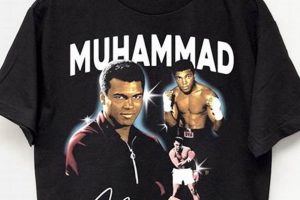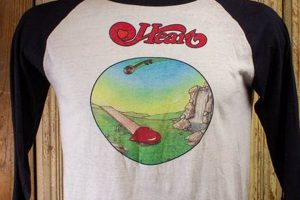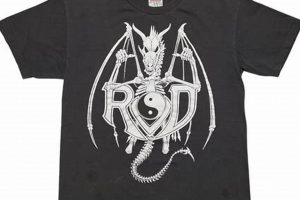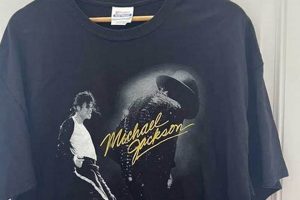Apparel featuring the likeness or branding associated with the iconic basketball player Michael Jordan, produced during an earlier period, typically before the early 2000s, is the subject of considerable interest. These items range from basic cotton tees displaying Jumpman logos to shirts commemorating specific championship wins or featuring unique designs from that era. For example, a 1990s-era tee showcasing Jordan’s image and the Bulls’ logo would fall into this category.
The value of these garments stems from several factors. Rarity plays a significant role, with limited-edition designs and those from pivotal moments in Jordan’s career commanding higher prices. Nostalgia also drives demand, as collectors and fans seek to recapture the era of Jordan’s dominance in basketball. Furthermore, the quality of the fabric and printing techniques used in the past often contribute to the desirability and collectibility of these items.
Understanding the market for these collectibles requires knowledge of key areas. Distinguishing authentic pieces from reproductions is crucial. Identifying significant design variations and assessing condition are also important skills. Finally, familiarity with the historical context surrounding particular designs enhances the appreciation and potential investment value of these sought-after items.
Essential Considerations for Acquiring Vintage Michael Jordan T Shirts
The acquisition of apparel bearing the likeness of Michael Jordan from previous decades requires careful consideration to ensure authenticity and value. The following guidelines offer a framework for navigating this market.
Tip 1: Scrutinize Manufacturing Details: Authentic items from the 1980s and 1990s often exhibit specific characteristics in their construction and labeling. Examine seams, stitching, and collar construction for indications of period-appropriate manufacturing techniques. Compare these details with known examples from reputable sources.
Tip 2: Analyze Tagging and Labeling: Vintage examples feature tags and labels distinct from modern reproductions. Research common manufacturers and label designs prevalent during the relevant era, such as Nike, Champion, or Starter. Pay close attention to font styles, logo placements, and material composition information present on the tags.
Tip 3: Assess Fabric Quality and Print Durability: The fabrics utilized in older garments possess a different texture and weight compared to contemporary materials. Evaluate the quality of the cotton or blend used. Additionally, examine the screen printing for signs of age, such as minor cracking or fading, which are consistent with genuine wear and storage over time.
Tip 4: Research Design Authenticity: Many designs have been reproduced or bootlegged over the years. Thoroughly research the specific designs sought after, comparing them against established databases or collector communities. Pay attention to details such as color accuracy, graphic proportions, and licensed logos to verify authenticity.
Tip 5: Evaluate Condition Carefully: The condition of the piece significantly impacts its value. Inspect for damage such as holes, stains, or excessive fading. Understand the implications of each flaw and factor it into the overall assessment of the item. A shirt in excellent condition will command a premium over one with significant wear.
Tip 6: Consult with Experienced Collectors: Seeking guidance from individuals with established expertise in this area can prove invaluable. Experienced collectors can offer insights into authenticity, value, and potential pitfalls. Their knowledge can help mitigate the risk of acquiring fraudulent or misrepresented items.
These points provide a foundation for making informed decisions when acquiring vintage apparel. Due diligence and careful evaluation are paramount to a successful transaction.
The next section will delve into strategies for maintaining the value of such collectibles.
1. Authenticity Verification
The verification of apparel attributed to Michael Jordan’s era is critical in determining value and collectibility. The market for these items is susceptible to reproductions, necessitating rigorous authentication processes.
- Tag and Label Analysis
Examination of tags and labels provides initial indicators of authenticity. Vintage apparel features specific manufacturer markings, font styles, and sizing conventions characteristic of the production era. Inconsistencies in these details raise suspicion. For example, a modern tag sewn onto a shirt purportedly from the 1990s is a red flag.
- Fabric and Construction Assessment
The textiles and construction techniques employed in apparel manufacturing have evolved. Vintage garments often utilize materials and stitching methods distinct from contemporary items. Analyzing the fabric composition, seam construction, and overall garment assembly provides clues regarding its age and authenticity. Modern materials used in a purported vintage shirt would indicate a reproduction.
- Print Quality and Design Accuracy
Screen printing techniques and design details offer further means of verification. Vintage prints exhibit a specific texture and aging pattern. Mismatches in color palettes, graphic proportions, or licensed logo placements can suggest a counterfeit. A design that deviates from established, documented designs of the period is a strong indicator of inauthenticity.
- Provenance and Documentation
Documentation, such as original receipts, photographs, or letters of authentication, adds credibility to a vintage apparel item. Provenance tracing the item’s ownership history contributes to establishing its authenticity. However, even with documentation, careful examination of the garment itself remains essential. Lack of verifiable provenance should prompt increased scrutiny.
The convergence of these authentication methods is vital for discerning genuine articles from reproductions. While no single factor guarantees authenticity, a comprehensive assessment minimizes the risk of acquiring misrepresented apparel. The collector must exercise diligence to ensure the integrity of their investment or collection.
2. Rarity Assessment
Rarity assessment is a critical component in determining the value of vintage Michael Jordan t shirts. The scarcity of a particular design, manufacturing period, or associated event directly correlates with its desirability and, consequently, its market price. Certain designs were produced in limited quantities, commemorating specific championships, anniversaries, or promotional campaigns. These limited-edition items inherently command a higher premium due to their reduced availability. A t-shirt produced exclusively for the 1993 NBA Finals, for example, would be significantly more valuable than a mass-produced shirt featuring the general Bulls logo from the same era.
The assessment of rarity requires meticulous research and a deep understanding of production cycles and distribution channels. Factors influencing rarity include the exclusivity of the design, the geographical limitations of its initial release, and the survival rate of the garment over time. T-shirts distributed solely at a single game or event, or those available only in certain regions, are rarer than items widely available in retail outlets. Further, condition plays a role in perceived rarity; even a common design in pristine condition can be considered relatively rare due to the challenges of preservation over decades. The practical implication is that careful examination of production details, distribution data, and condition assessment are crucial to accurately determine the rarity of a specific item.
In conclusion, the relationship between scarcity and value is fundamental in the realm of vintage Michael Jordan t shirts. Accurate rarity assessment, based on historical data, production analysis, and condition appraisal, provides the framework for collectors and investors to make informed decisions. The inherent challenges in verifying production numbers and tracing distribution paths necessitate a combination of research, expertise, and careful inspection to navigate this market effectively. A thorough understanding of rarity elevates the appreciation of these collectible garments beyond mere apparel, recognizing them as artifacts representing a specific moment in sports history.
3. Condition Evaluation
The assessment of physical condition represents a pivotal determinant in the valuation and desirability of vintage Michael Jordan t shirts. Given the age and potential wear associated with these items, a rigorous evaluation of their condition is paramount to accurately gauge their market worth.
- Fabric Integrity
The state of the fabric itself is a primary consideration. Degradation due to age, improper storage, or frequent use manifests in various forms, including thinning, discoloration, and the presence of holes or tears. A shirt exhibiting significant fabric damage will command a lower price compared to one with well-preserved fabric. For instance, a t-shirt stored improperly, leading to moth damage, would be devalued significantly compared to the same shirt stored in a climate-controlled environment.
- Print Quality and Integrity
The condition of the graphic print significantly influences value. Cracking, fading, or peeling of the print diminishes its aesthetic appeal and indicative of wear. A print that retains its original vibrancy and exhibits minimal wear is highly desirable. Consider a shirt with a Jumpman logo where the logo is heavily cracked and faded compared to a shirt where the logo remains largely intact and vibrant.
- Staining and Discoloration
The presence of stains or discoloration negatively impacts the perceived value. Stains, whether from spills, sweat, or other sources, detract from the overall presentation. Discoloration, often resulting from prolonged exposure to sunlight, alters the original color of the fabric and print. A pristine white t-shirt with yellowing due to age is less desirable than one that has retained its original color.
- Structural Integrity
The garment’s structural integrity, including seams, collar, and cuffs, also plays a role. Loose seams, stretched collars, or frayed cuffs indicate wear and can impact the overall presentation. A shirt with intact seams and a well-maintained collar holds greater value than one exhibiting signs of structural deterioration. For example, a t-shirt with a stretched-out collar loses significant value compared to the same shirt with a tight, original collar.
The aggregate impact of these condition factors directly translates to the market value of vintage Michael Jordan t shirts. A comprehensive assessment, accounting for fabric integrity, print quality, staining, and structural soundness, provides a framework for establishing accurate valuations and distinguishing between highly sought-after examples and those with diminished appeal.
4. Design Uniqueness
The distinctiveness of design significantly impacts the valuation and collectibility of vintage Michael Jordan t shirts. Unique design elements, whether stemming from limited-edition releases, specific event commemorations, or artistic collaborations, contribute substantially to their appeal and market value.
- Limited Edition Graphics
Apparel produced with graphics specifically for a short-term promotional campaign or a single event, such as a championship celebration, often exhibits unique artwork. These designs, due to their limited production run, are highly sought after. An example is a t-shirt given exclusively to attendees of a specific playoff game. The unique graphic associated with that event differentiates it from mass-produced merchandise, increasing its value.
- Collaborative Artworks
Designs incorporating the work of notable artists or designers, licensed for a specific production run, contribute to the uniqueness of a garment. These collaborations result in distinct visual aesthetics not found in standard merchandise. An example is a shirt featuring a stylized rendition of Michael Jordan by a recognized artist. The artwork’s unique style and the artist’s reputation enhance the garment’s desirability.
- Variations in Print Techniques
Subtle variations in printing techniques, such as the use of different inks, color palettes, or screen-printing methods, can create unique versions of seemingly identical designs. These variations, often unintentional, differentiate one garment from another. A shirt with a slightly different shade of red in the Bulls logo, due to a printing error, could be considered a unique and collectible item.
- Unauthorized or Bootleg Designs
While authenticity is generally paramount, some collectors value unauthorized or “bootleg” designs from the era. These designs, created without official licensing, often feature unconventional artwork or humorous takes on Jordan’s image. Their scarcity and the rebellious nature of their creation contribute to their unique appeal. A shirt featuring a crudely drawn caricature of Jordan might be considered a unique, albeit unofficial, piece of memorabilia.
These aspects of design uniqueness, from officially sanctioned limited editions to unauthorized creations, play a crucial role in shaping the market for vintage Michael Jordan t shirts. Collectors seek out these unique elements as markers of rarity and individuality, driving demand and contributing to the overall appreciation of these garments as historical artifacts.
5. Era Significance
The historical context of Michael Jordan’s career significantly influences the value and collectibility of apparel associated with him. Each era from his early years with the Chicago Bulls to his championship runs and eventual retirement holds unique significance that is reflected in the designs, logos, and materials used in the respective garments. A t-shirt from the 1980s, for instance, represents a period of burgeoning fame and initial market saturation, while those from the 1990s are tied to the Bulls’ dynasty and global expansion of the Jordan brand. Garments connected to specific milestones, such as championship victories or MVP awards, are particularly sought after. A shirt commemorating the 1991 NBA Finals victory holds more historical weight, and thus higher value, than a generic Jordan-branded shirt from the same year.
The correlation between historical context and market value extends to the cultural impact of Jordan’s influence. During his prime, his style and endorsements shaped fashion trends and consumer preferences. Apparel mirroring these trends or reflecting specific marketing campaigns from that time holds nostalgic appeal for collectors. Further, the rarity of apparel from certain periods contributes to its value. Items produced in smaller quantities or those tied to fleeting moments in Jordan’s career are inherently more desirable. Understanding the specific events, marketing initiatives, and production volumes associated with each era is, therefore, crucial in assessing the authenticity and value of these collectibles. For instance, a shirt associated with a specific Nike advertising campaign from the early 1990s can command a higher price due to its direct tie to a specific cultural phenomenon.
In summary, era significance is not merely a chronological marker but a fundamental element that defines the worth of these items. The interplay of historical events, marketing campaigns, and production quantities directly shapes collector preferences and market valuations. The ability to discern era-specific details is paramount for enthusiasts seeking to acquire authentic and historically relevant apparel. The challenge lies in the need for comprehensive research and a nuanced understanding of the cultural landscape that defined Michael Jordan’s era to effectively evaluate these collectible garments.
6. Market Demand
The economic principle of market demand exerts a powerful influence on the valuation of vintage Michael Jordan t shirts. Consumer interest, collector enthusiasm, and investment potential converge to dictate the desirability and price points for these items.
- Nostalgia and Cultural Significance
The nostalgia associated with Michael Jordan’s era, coupled with his enduring cultural impact, fuels significant demand. Individuals who witnessed Jordan’s career firsthand often seek these items to reconnect with a specific period of their lives or to own a piece of sports history. Examples include fans who attended Bulls games in the 1990s and now seek to recapture that experience through apparel. This emotional connection directly impacts market value.
- Collector Base and Investment Potential
A dedicated collector base actively seeks rare and well-preserved vintage items. Collectors often specialize in specific eras, designs, or manufacturers, driving up demand for those particular items. The perception of these t-shirts as potential investments further amplifies this effect. Limited-edition shirts, for instance, are often viewed as assets with appreciating value over time, attracting investors alongside dedicated collectors. This dual appeal significantly strengthens market demand.
- Media Influence and Hype
Media coverage, documentaries, and social media trends can directly impact the demand for vintage Michael Jordan t shirts. When documentaries or television shows highlight Jordan’s career or the cultural impact of his brand, interest in associated merchandise spikes. This creates a ripple effect, driving up prices and increasing the overall visibility of these items. The “Last Dance” documentary, for example, led to a surge in demand for vintage Bulls apparel.
- Supply Scarcity and Condition
The limited supply of truly vintage t-shirts, coupled with the challenges of finding them in good condition, further intensifies market demand. As time passes, fewer original shirts survive, and those that do are often subject to wear and tear. The scarcity of pristine examples leads collectors to compete for the best available options, driving up prices and creating a premium for well-preserved items. This scarcity is a primary driver of sustained high demand.
These facets converge to create a dynamic market for vintage Michael Jordan t shirts, where nostalgia, collector zeal, media influence, and supply scarcity interact to shape pricing and desirability. The interplay of these factors ensures that demand remains a critical element in the valuation of these collectibles.
7. Material Composition
The material composition of apparel associated with Michael Jordan’s era is a critical determinant of its authenticity, durability, and collectibility. The fabrics utilized in vintage garments differ significantly from modern textiles, owing to advancements in manufacturing processes and shifts in consumer preferences. Typically, apparel from the 1980s and 1990s features heavier-weight cotton or cotton-polyester blends. The proportion of cotton to polyester affects the garment’s breathability, shrinkage, and overall feel. A t-shirt predominantly composed of cotton is more likely to exhibit natural wear patterns, such as fading and softening, over time compared to a polyester blend. Therefore, the material composition serves as an initial indicator of the garment’s age and potential authenticity.
The type of dye employed in the fabric also contributes to its distinctiveness. Early printing techniques often utilized dyes that faded and aged differently than modern, more stable dyes. This aging process is a factor in identifying genuine vintage items. For instance, a screen-printed design featuring a particular shade of red common in the 1990s may exhibit a specific type of fading that is difficult to replicate accurately with modern dyes. Moreover, the label content and its associated materials directly reflect manufacturing practices, thus affecting durability. Vintage t-shirts frequently have tags made of specific materials (e.g., satin or woven cotton) with printing details and manufacturer details. These tags need to be intact and readable for collectors to identify the history and origin of the apparel. The material properties, therefore, greatly influence the long-term preservation potential of this apparel.
In summary, the understanding of material composition in vintage Michael Jordan apparel provides valuable insights into authenticity, age, and overall condition. Knowledge of the fabrics, dyes, and manufacturing techniques prevalent during specific periods enables collectors and enthusiasts to distinguish genuine items from modern reproductions. The fabric composition directly correlates to the long-term preservation of the item, and a keen eye can determine if the t-shirt aligns with accepted material properties for that era. Challenges in accurately dating and authenticating items underscore the importance of comprehensive material analysis in the assessment of these collectibles. Furthermore, understanding this attribute also helps align the garment with its historical and cultural setting.
Frequently Asked Questions
The following questions address common inquiries regarding vintage Michael Jordan t shirts. These responses aim to provide clarity and informed perspectives on key aspects of collecting and valuing these items.
Question 1: How can the authenticity of apparel attributed to Michael Jordan’s career be reliably verified?
Verification requires a multi-faceted approach. Scrutiny of manufacturing details, assessment of tagging and labeling, analysis of fabric quality and print durability, and research into design authenticity are essential. Consultation with experienced collectors is also recommended.
Question 2: What factors contribute to the rarity of a vintage Michael Jordan t shirt?
Rarity is influenced by limited production runs, event-specific designs, geographical limitations on initial release, and the survival rate of the garment over time. Condition also plays a significant role, as pristine examples of even common designs are considered relatively rare.
Question 3: How does the condition of a vintage t shirt impact its market value?
Condition is a primary determinant of value. Fabric integrity, print quality, the presence of stains or discoloration, and structural soundness are all assessed. A shirt in excellent condition will command a premium over one exhibiting significant wear or damage.
Question 4: What design elements contribute to the uniqueness and desirability of a vintage shirt?
Limited edition graphics, collaborative artworks, variations in print techniques, and even unauthorized or bootleg designs can contribute to uniqueness. These elements differentiate a garment and enhance its appeal to collectors.
Question 5: How does the historical context of Michael Jordan’s career impact the value of associated apparel?
Each era of Jordan’s career holds unique significance, reflected in the designs and materials used in garments from that period. Apparel connected to specific milestones, such as championship victories, is particularly sought after.
Question 6: What is the role of market demand in determining the value of vintage Michael Jordan t shirts?
Market demand is driven by nostalgia, collector enthusiasm, investment potential, media influence, and supply scarcity. These factors converge to shape the desirability and price points for these items.
In summary, acquiring and valuing these collectible garments requires a comprehensive understanding of authenticity, rarity, condition, design, historical context, and market forces. Careful research and informed decision-making are paramount.
The next section will explore care and preservation techniques for maintaining the value of these collectibles.
Concluding Observations on Vintage Michael Jordan T Shirts
The preceding exploration has illuminated the multifaceted nature of apparel featuring Michael Jordan from earlier eras. Critical evaluation factors, encompassing authentication protocols, rarity determinants, condition assessments, design uniqueness, and the significance of historical context, are paramount. A discerning approach, predicated on meticulous research and expert consultation, is essential for navigating this market effectively.
The value of garments tied to Jordan’s legacy extends beyond mere apparel; these items serve as tangible representations of a pivotal era in sports history. Prudent acquisition and conscientious preservation ensure the continued appreciation of these artifacts, benefiting both collectors and the broader cultural landscape. Vigilance and informed participation are critical to sustaining the integrity of this market.







